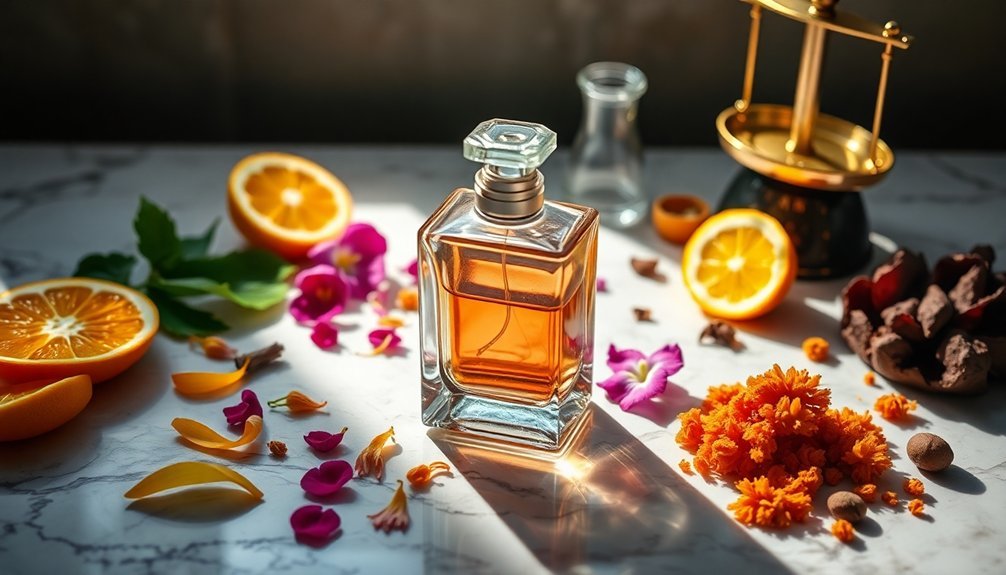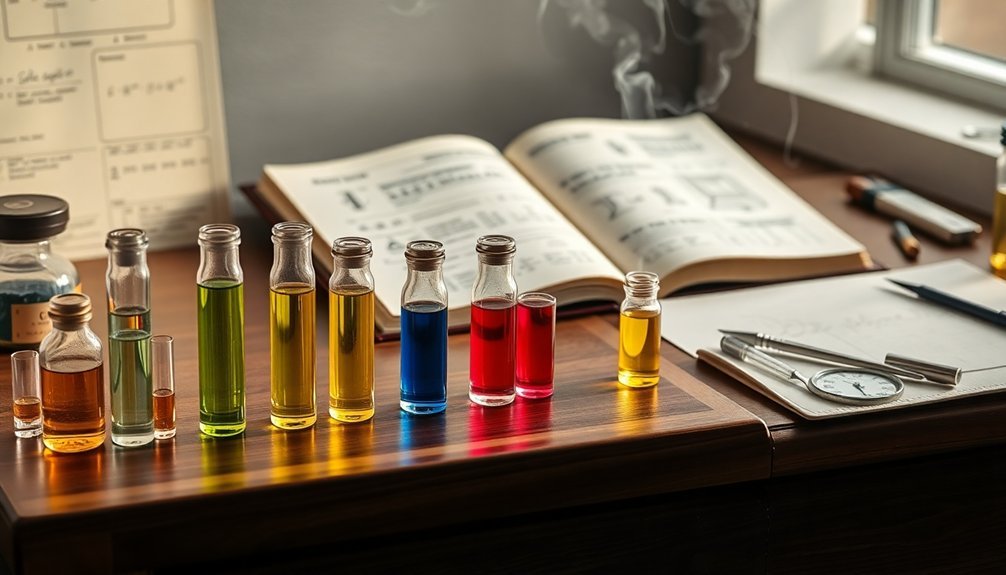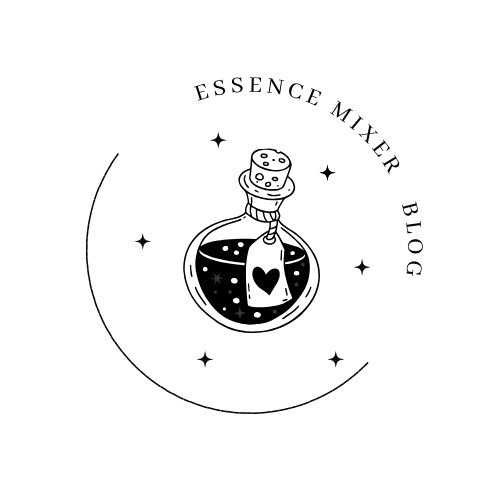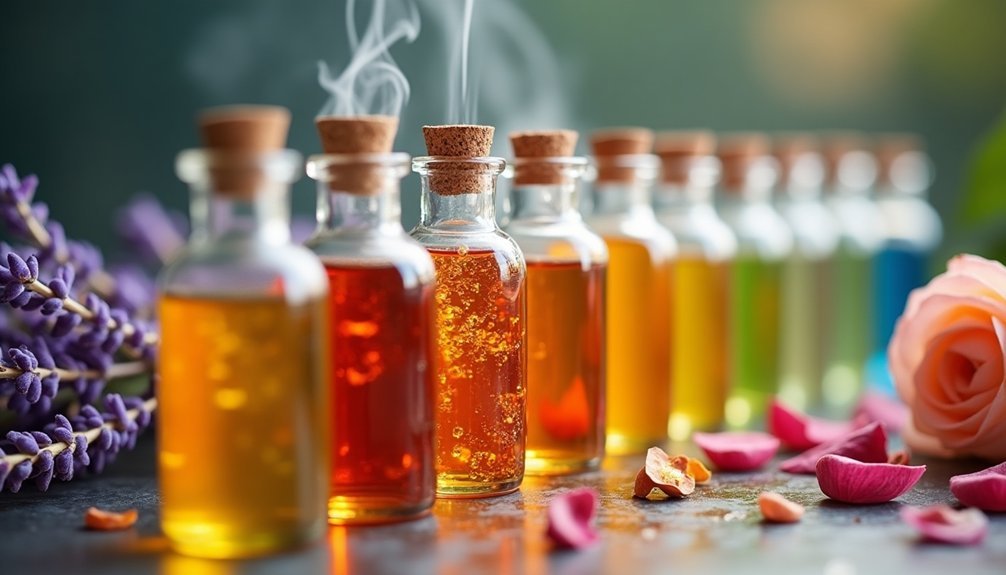Follow five science-backed rules to create perfect perfumes: Start with the 80/20 ratio (20% fragrance oils to 80% carrier base), balance vapor pressures around 0.01 mmHg for ideal diffusion, apply the three-tier system (10-30% top notes, 40-60% heart notes, 20-50% base notes), blend natural and synthetic materials in a 30/70 split, and use the Jean Carles method for systematic ingredient combinations. These foundational principles will transform your understanding of professional perfume creation.
The 80/20 Rule: Mastering Fragrance Oil Concentrations

Perfume artistry hinges on the foundational 80/20 rule, where fragrance oils and carrier bases combine to create the perfect balance.
You'll achieve ideal results by mixing 20% fragrance oils with 80% carrier base in your formulations.
If you're working with a 100ml bottle, measure out 20ml of fragrance oils and combine them with 80ml of your carrier base.
For sensitive skin, you can adjust to a 15% concentration while maintaining efficacy.
When using a 5ml rollerball, aim for 20 drops of essential oils with 80 drops of carrier oil.
Remember to add your oils gradually and mix thoroughly for even distribution.
Grapeseed oil provides an excellent base due to its lightweight, non-greasy properties.
Let your creation mature for several weeks to develop its full character.
Always use precise measurements and perform a patch test before application.
Understanding Vapor Pressure for Optimal Note Balance
When crafting exceptional fragrances, understanding vapor pressure becomes essential for achieving the perfect balance of notes.
You'll find that vapor pressure directly impacts how quickly different ingredients evaporate and diffuse on the skin. By calculating the weighted average of your mixture's vapor pressure, you can predict how your fragrance will perform over time. Studies show that successful commercial perfumes typically maintain a total vapor pressure around 0.01 mmHg.
- Use high vapor pressure materials (like citrus oils) for vibrant top notes that create immediate impact
- Select moderate vapor pressure ingredients for heart notes to guarantee smooth shifts
- Choose low vapor pressure materials (such as woods and resins) for long-lasting base notes
- Incorporate fixatives strategically to stabilize your overall fragrance composition
Your precision in balancing vapor pressures will determine how well your fragrance develops, from the initial spray to its final dry-down.
The Three-Tier System: Calculating Top, Heart, and Base Ratios

Building on our understanding of vapor pressure, let's explore the mathematical foundation of fragrance composition – the three-tier system. You'll find that creating the perfect fragrance requires balancing three distinct note categories, each with specific ratios and roles. Precise measurements using graduated cylinders ensure accuracy when mixing these proportions.
| Note Type | Typical Range |
|---|---|
| Top Notes | 10-30% |
| Heart Notes | 40-60% |
| Base Notes | 20-50% |
| Summer Blend | Higher top % |
| Winter Blend | Higher base % |
While these percentages serve as a starting point, you'll need to adjust them based on your fragrance's theme and character. Summer fragrances often demand more top notes for freshness, while winter scents lean heavily on heart and base notes. Remember that these ratios aren't fixed rules – they're guidelines that you'll refine through testing and maturation.
Natural vs. Synthetic Material Proportions
Understanding the interplay between natural and synthetic materials forms the cornerstone of modern perfumery.
You'll find that while natural ingredients bring unique, soulful qualities to your formula, they often require higher proportions to achieve the desired impact due to their subtle nature.
Synthetic materials, on the other hand, can deliver consistent, long-lasting performance even in smaller quantities.
- Natural materials typically comprise 15-30% of a formula, focusing on essential oils and absolutes for authenticity
- Synthetic components usually make up 70-85%, providing stability and projection
- Consider using synthetic fixatives to extend the life of natural ingredients
- Balance cost efficiency by using synthetics to replicate rare natural scents while maintaining select premium natural materials for depth
When blending, you'll want to leverage synthetics' longevity while preserving the distinctive character that natural materials provide.
The Jean Carles Method for Quantitative Blending

The revolutionary Jean Carles Method transformed perfumery by introducing a systematic approach to fragrance creation.
You'll start by organizing 60 key odourants into categories like floral and woody, then learn to compare and contrast materials within each class.
When you're blending materials, you'll test different ratios (1:9, 2:8, 3:7) to find ideal combinations.
You'll build your perfume from the ground up, starting with base notes before adding middle and top notes. This structured technique helps you understand how different materials interact and create harmonious accords.
While the method isn't foolproof – you'll still need extensive knowledge of materials and their volatility – it's an invaluable foundation for learning perfumery.
Modern adaptations have improved its precision by incorporating factors like vapor pressure.
Frequently Asked Questions
How Do Temperature and Humidity Affect the Performance of Fragrance Formulations?
Heat speeds up your fragrance's evaporation while humidity helps it last longer. You'll notice stronger scents in warm weather, but they'll fade faster. Cold temperatures slow evaporation, making fragrances last but project less.
What Role Do Fixatives Play in Extending the Longevity of Perfumes?
Fixatives extend your perfume's longevity by binding to volatile fragrance molecules, slowing their evaporation rate. They'll anchor the scent to your skin, creating a stable base that releases the fragrance gradually over time.
How Do Skin Chemistry Variations Impact Perfume Formula Effectiveness?
Your skin type dramatically affects how perfumes perform – oily skin amplifies scents and extends wear time, while dry skin causes faster evaporation. Your body temperature, diet, and pH levels also influence fragrance effectiveness.
Can Mathematical Modeling Predict Successful Fragrance Combinations Before Practical Testing?
Yes, you'll find that mathematical models can predict successful fragrance combinations by analyzing molecular interactions, vapor-liquid equilibrium, and complex network patterns of successful perfumes, though they can't entirely replace practical testing.
What Methods Determine the Optimal Aging Time for Perfume Formulations?
You'll determine ideal perfume aging time by monitoring ingredient types, testing at regular intervals, and documenting changes. Track how natural essences develop complexity while considering your carrier medium and storage conditions.
In Summary
You'll find that mastering these five scientific principles transforms your perfume creation from guesswork to precision. By applying the 80/20 rule, understanding vapor pressure dynamics, balancing your three tiers, mixing natural and synthetic materials strategically, and following Jean Carles' proven blending method, you're now equipped to create fragrances that aren't just pleasant – they're scientifically sound. Start experimenting with these rules to develop your signature scent.





Leave a Reply